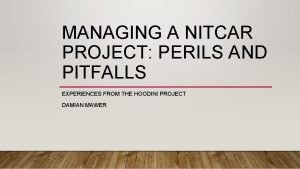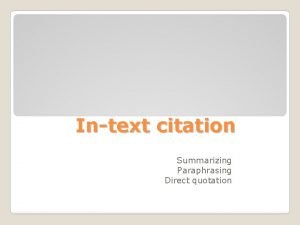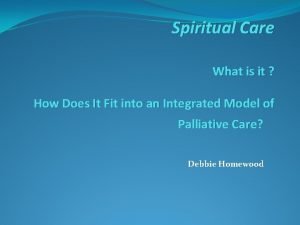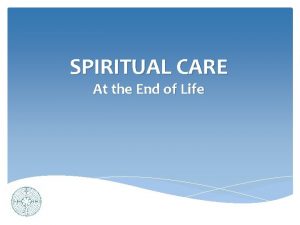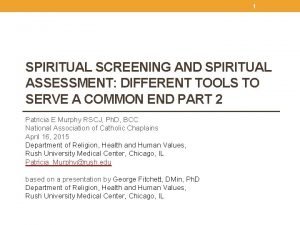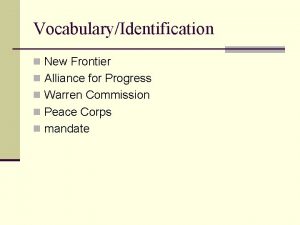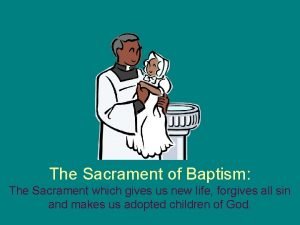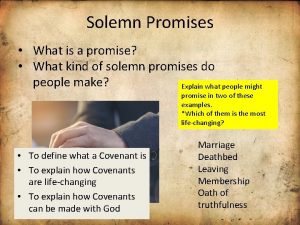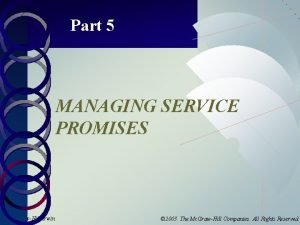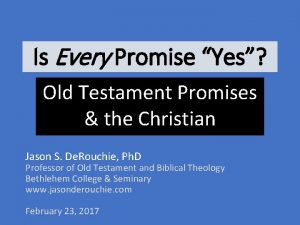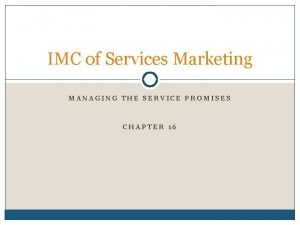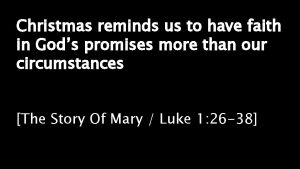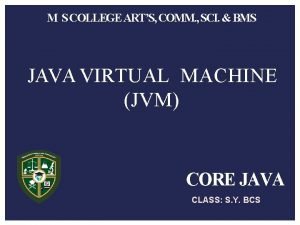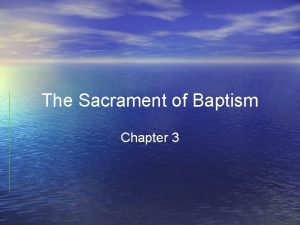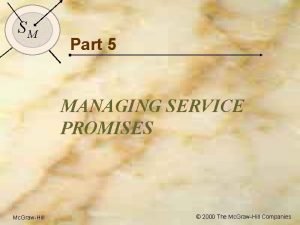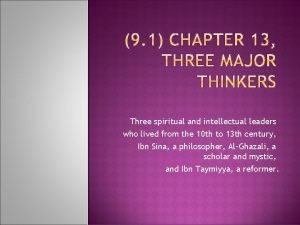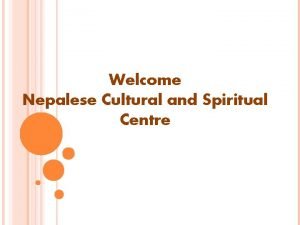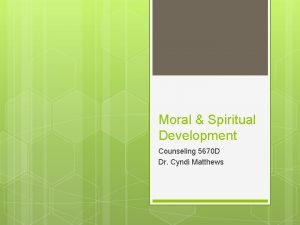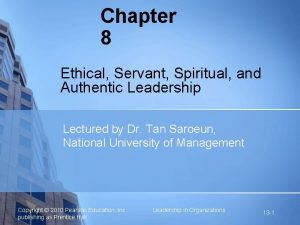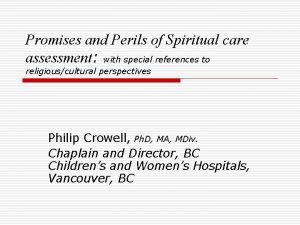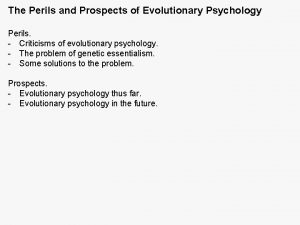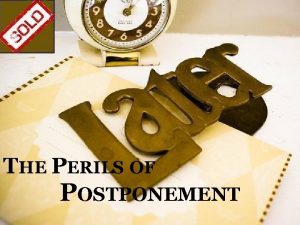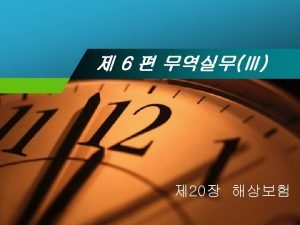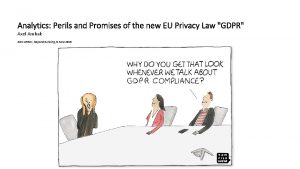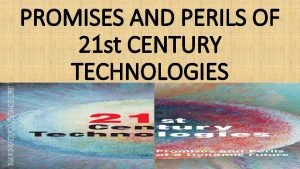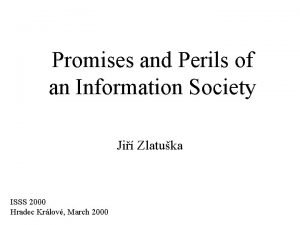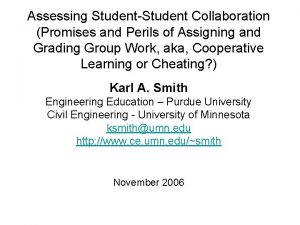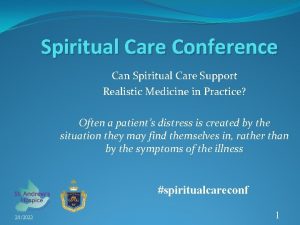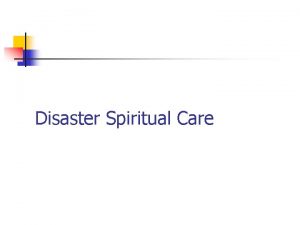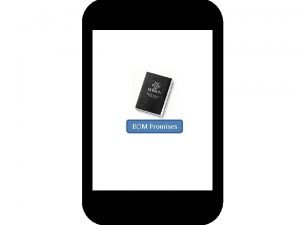Promises and Perils of Spiritual care assessment with










































- Slides: 42

Promises and Perils of Spiritual care assessment: with special references to religious/cultural perspectives Philip Crowell, Ph. D, MA, MDiv. Chaplain and Director, BC Children’s and Women’s Hospitals, Vancouver, BC

Promises & Perils o The reality - we need to do it… o Great benefit when it is done right o The need for competency in order to do it appropriately o Assessment, interpretation, evaluation, measurement is part of our culture with respect to another person/family and their culture

The Art of Spiritual Assessment o Is there an art, science and skill involved that goes beyond the assessment questions? o The value of the inner wisdom and selfawareness of the assessor? o How important is the arete, skill, virtue and competency of the assessor and interpreter? The art of questions…. o What do we see when we enter a hospital room?

From Illness and Healing: Images of Cancer – by Robert Pope o “Cancer in older people carries with it a tacit acknowledgement of inevitability, but in children we are surprised, and uncomprehending. ” o “In this drawing, Erica, with hair gone from the treatments, touches the pump that administers her chemotherapy. ”

Perils and Promises: In using tools we are able to take a measure at a moment in time o A toolkit of supplies – JPCC vol. 59, nos 12 Spring-Summer, 2005, Thomas St. James O’Connor, Kathleen O’Neill, Grace Van Staalduinen, Elizabeth Meakes, Carol Penner, and Katherine Davis, “Not Well Known, Used Little and Needed: Canadian Chaplains’ Experiences of Published Spiritual Assessment Tools”

Tools Spiritual Assessment Tools Religious Attitude Inventory o W. E. Broen, “Personality Correlates of Certain Religious Attitudes, “Journal of o Consulting Psychology, 1955, vol. 19, p. 23; David Foy, James D. Lowe, Lee K. Hildman, & Keith Jacobs, “Reliablity, Validity and Factor Analysis of the Religious Attitude Inventory” Southern Journal of Educational Research, 1976, Vol 10, pp. 235 -241.

tools o Gordon Allport and James Ross, “Personal Religious Orientation and Prejudice, ” Journal of Personality and Social Psychology, 1967, Vol. 5, pp. 432 -443; o Michael J. Donahue, “Intrinsic and Extrinsic Religiousness: The Empirical Research, ” Journal for the Scientific Study of Religion, 1985, Vol. 24, pp. 418 -423. Ralph W. Hood, “The Conceptualization of Religious Purity in Allport’s Typology, “Journal for the Scientific Study of Religion, 1985, vol. 24, pp. 413417;

And even more tools o R. W. Hood, “The Construction and Preliminary Validation of a Measure of Reported Mystical Experience, ” Journal for the Scientific Study of Religion, 1975, Vol. 14, pp. 29 -41.

The last of the tools…. There will be more o C. Daniel Batson, “Religion as Prosocial: Agent or Double Agent, ” Journal for the Scientific Study of Religion, 1976, Vol. 15, pp. 29 -45. o Keith Edwards, “Religious Experience Questionnaire, ” Dissertation Abstracts International, 1976, Vol. 36. The God Questionnaire o Anna-Maria Rizzuto, The Birth of the Living God: A Psychoanalytic Study (Chicago, ILL: The University of Chicago, 1979).

Fitchett 7 x 7 Model of Spiritual Assessment o George Fitchett, Assessing Spiritual Needs: A Guide for Caregivers (Minneapolis, MN: Augsberg Fortress Press, 1993); also see, G. Fitchett and J. Russell Burch, “A Multi-Dimensional Functional Model for Spiritual Assessment, ” The Caregiver Journal, 1990, vol. 7, pp. 43 -62. Mental, Physical and Spiritual Well-Being Scale o Dianne Vella-Brodrick and Felicity Allen, “Development and Psychometric Validation of the Mental, Physical, and Spiritual Well-Being Scale, ” Psychological Reports, 1995, Vol. 77, pp. 659 -674.

Assessment and interpretation Spiritual Self-Assessment Form o Lyn Brakeman, “Theology as a Diagnostic Tool in Assessing Spiritual Health, ” The Journal of Pastoral Care, 1995, Vol. 49, pp. 29 -38. Spiritual Assessment Inventory o Todd Hall and Keith Edwards, “The Initial Development and Factor Analysis of the Spiritual Assessment Inventory, ” Journal of Psychology and Theology, 1996, Vol. 24, pp. 233 -246; Todd Hall and Keith Edwards, “The Spiritual Assessment Inventory: A Theistic Model and Measure for Assessing Spiritual Development, ” Journal for the Scientific Story of Religion, 2002, Vol. 41, pp. 341 -357.

Spiritual assessment 1: Fitchett o Problems with a medical model o Assessment is both a statement of perception and a process of information gathering and interpreting. o “I use the term assessment as a noun and a verb. Because it is both process and content, it is inherently a dynamic concept. ” George Fitchett, Assessing Spiritual Needs, p, 17

Continued - 2 o Multi-focused assessments are often guided by questions such as: what does this person want? o What do I think he needs? Do I feel qualified to help her? o What kind of help is expected or required of me in the institutional context of this assessment (compare the patient’s hospital room and the parish pastor’s office)?

Assessment -3 o What are the likely consequences if I elect to do more or to do less than expected? o What other departments or services will also be involved in the patient’s care? o What additional resources will be need to help this person or to help me help him? o Are those resources available? If not, is it better to postpone any intervention until they are?

Assessment 4 o When is the best time to make an assessment? o A chaplain in Fitchett’s survey was careful not to make an assessment until he had gotten to know a patient, during a second visit at the earliest. o However, one sizes up a situation as soon as you enter a room, i. e. , “am I welcome here today or not? ”

Spiritual Care/Pastoral Counselling Core Competencies January 2010 / March 2010 o This document is a first attempt to summarize the core competencies (knowledge, skills, attitudes, behaviours) that are required for the practice of Spiritual Care/Pastoral Counselling. These competencies can be observed, demonstrated, evaluated and assessed. o The following nine competency categories were derived from the National Validation Survey (2008) which included competencies identified through the DACUM project (2006). The actual competency statements validated through the survey are grouped under these main categories.

“A top ten list” o o o o o Spiritual Assessment Self-Awareness Spiritual and Personal Development Multi-dimensional Communication Brokering Diversity Ethical Behaviour Collaboration & Partnerships Facilitating Learning Leadership Research

Spiritual Assessment (includes the development of care plan, implementation and evaluation of outcomes) o o o o A. 4 Create spiritual care plan. 1 B. 2 Utilize evidence-based practice. 3 B. 4 Identify person's sense of purpose 1 B. 5 Help person evaluate role and function of spiritual religious identity in their life. 1 B. 7 Invite clients to draw upon their spiritual and religious resources. 1 B. 10 Employ a variety of intervention techniques to achieve care plan goals (or therapy goals and objectives). 1 B. 12 Engage in reflection and dialogue on spiritual issues of significance to the client. 1 B. 13 Allow client to tell his / her story as a way to seek for meaning / purpose. 1

Continued -Compiled by Becky Vink, January 11, 2010 Modified by Margaret Clark, March 1, 2010 o o o o o B. 14 Engage with client's experiences of (trauma, distress) pain, suffering and dying. 1 B. 15 Acknowledge the sacred in human experience. 1 B. 16 Assist persons in their own creative expression of spirituality. 1 B. 17 Offer guidance for spiritual growth. 4 B. 18 Engage in prayer where appropriate. 4 B. 19 Enable reconciliation (e. g. conflict management forgiveness, relationship). 5 B. 20 Provide and facilitate rituals, rites and ceremonies. 2 B. 24 Function as primary therapist / clinician / spiritual counsellor as required. 3 E. 1 Assess the dynamics of the culture, resources and community. 3

Assessment on assessment 5 o In medicine, the patient has an admitting diagnosis, a subsequent assessment confirmed or revised diagnosis/ assessment that guides therapy o For example, In DSM IV the diagnosis of Schizophrenia requires that continuous signs of the illness have been present for at least six months.

Assessment 6 – “over-time” o In psychoanalytic treatment of narcissistic personality or behavior disorders, according to H. Kohut, it is necessary to wait to see if one of the characteristic narcissistic transferences develops before one makes a definitive diagnosis.

Importance of spiritual assessment o o o o Foundation for action Foundation for communication Foundation for contracting Foundation for evaluation Foundation for personal accountability Foundation for quality assurance Foundation for research Assessment as the touchstone for profession’s identity

7 X 7 Model for Spiritual Assessment - assumptions o Each of us is a whole person o Our spirits are not separate from our bodies, our emotions, and our thoughts o There are two major divisions and 7 dimensions within each

Holistic Dimensions -7 o o o o Medical context dimensions Psychological state dimensions Psychosocial dimension Family system dimensions Ethnic and cultural dimensions Societal issues dimensions Spiritual dimensions

The Spiritual Dimensions (7 pts) 1. Beliefs and Meaning- stories – religious symbols – literal, broken myth, and restored myth – noting the inconsistencies of the stories – meaning from caring for others – for her husband 2. Vocation and consequences – duties called to fulfill – able to fulfill? Impasse? 3. Experience and Emotion – what experiences of peace in life have been experience? Or joy?

Spiritual dimension – 7 x 7 4. Courage and Growth – courage to be – to enter the dark night of the soul – “living wake” – the possibility of new beliefs? Has growth been slow or sudden? 5. Ritual and Practice 6. Community – RC parish, her partner – is the community as resource for the patient? 7. Authority and Guidance – will the patient allow the chaplain to help, support, and offer guidance when struggling?

A case – Mrs. Gabatino o facing her own death and cancer o Reflecting on her faith, partner, the death of an infant - SIDs, no other children, 7 foster children, Italian background, o Anxiety absent, grateful, joyful, angry, exhausted, timid, worthless, and guilty.

What is our approach in contrast to genetic counseling assessment? o Genetic testing and information often raises issues that are existential, having to do with illness, suffering, loss, choices and death o Spiritual and religious values will influence how some people respond to genetic information o (“Religious and Spiritual Concerns in Genetic Testing and Decision Making: An Introduction for Pastoral and Genetic Counselors” Journal of Clinical Ethics, Summer 2006)

Ethical decisions o They may reconsider their feelings about being induced or abortion and worry about how their family, friends, and religious communities may react o Spectrum- from anacephaly to trisomy 21 o They may worry about what the future might bring for the child, knowing that life, at some level, is always a struggle, but harder for those who are disabled

Genetic and spiritual care counselors o Can be a tremendous help to parents grappling with these questions. o Help identify their social, psychological and spiritual resources o Seek to dispel any misperceptions about the cause or effects of a genetic abnormality and minimize negative thought patterns (blame/guilt)

The basics o assessing various traumatic situations so we can respond o Spiritual care may include the ability to make a spiritual assessment and to follow up - and/or to conduct rituals, helping people to draw on the positive elements of their faith-beliefs, or rituals of lament/sorrow

Integration o Park Ridge Center for Health, Faith and Ethics (2004) study encourages genetic counselors to learn about different religious frameworks and language to effectively assess patients’ spiritual needs o Caution about any directive counseling – assessing other counselors involved o Will some want guidance and affirmation?

The Balance o the danger of stereo-typing vs. not knowing their basic cultural/religious assumptions o What to ask? The same questions will mean very different things to different individuals because of their cultural lens

The spiritual/ethical questions in context: E. o. L. settings, inductions, palliative care o What is a good life? What is our responsibility to limit human suffering? To allow natural death? To have a D. N. A. R. ? o What is the place of hope? o Will it be better to be born then not to be born? Will I be the same person if I make a termination decision? What will it be like, since I have never experienced a loss or death of someone close?

Our questions o Do you have the time, or skills to assess and attend to their spiritual needs? o The perils and the possibilities of spiritual care “triage”

A consultation - assessment o The Case: newborn, rare genetic condition, respiratory failure, “softbones”, constrictive ribs, heartsurgery necessary, resuscitation o 2 months later – H 1 N 1 o Aboriginal family, Catholic and traditional way o Modes of communication

Pediatric case o Perinatal diagnosis – 8 months pregnancy o Large mass discovered on the throat of baby o 1) wait delivery and immediate surgery – risk of oxygen debt o (2) wait delivery and go palliative o (3) ‘exit surgery’ o The couple not religious but spiritual with background in the UCC.

Spiritual Assessment in Genetic Counseling o Journal of Genetic Counseling, vol. 16, No. 1 Feb. 2007 o 60% in a group of 127 genetic counselors, reported they had performed a spiritual assessment within the past year, however, 8% of these counselors assessed spirituality in more than half of their sessions

Barriers to spiritual assessment o Lack of time, insufficient skills, uncertainty regarding the role of spiritual assessment within genetic counseling o This study suggests a need for increased training regarding the methods for and relevance of spiritual assessment in g. c.

Back to holistic care o Harold Koenig stated, “neglecting the spiritual dimension is just like ignoring a patient’s social environment or psychological state, and results in failure to treat the whole person. ” (2002, p. 6)

Spirituality in Patient Care, by Harold Koenig, p. 44) Single Question Spiritual History: “Do you have any spiritual needs or concerns related to your health? ”

Fear and Hope o “The suffering human being needs a place where he/she can rest, a place which breathes genuine hospitality, where fear and hope are permitted to exist side by side… a place where the naked face appeals for compassion and finds response. ” (Eriksson & Lindstrom, 2003)
 Nitcar
Nitcar Direct quotation
Direct quotation 1 corinthians 2:9-13
1 corinthians 2:9-13 Primary, secondary, tertiary care
Primary, secondary, tertiary care What is spiritual care
What is spiritual care What is spiritual care
What is spiritual care Fitchett 7x7 spiritual assessment
Fitchett 7x7 spiritual assessment Spiral dynamics
Spiral dynamics Spiritual maturity assessment
Spiritual maturity assessment Frontiern
Frontiern Baptismal promises
Baptismal promises Solemn promises
Solemn promises Promises of ddb
Promises of ddb Managing service promises
Managing service promises Old testament promises
Old testament promises Managing service promises
Managing service promises Self perceived service role
Self perceived service role Believing in god's promises
Believing in god's promises Faraj from promises
Faraj from promises Manifesto for head girl
Manifesto for head girl Security promises of the jvm
Security promises of the jvm Notes receivable amortization table
Notes receivable amortization table Conditional promises of god
Conditional promises of god Promises of ddbms
Promises of ddbms The one who reigns forever he is a friend of mine
The one who reigns forever he is a friend of mine God's covenant
God's covenant Zephaniah 3 14-17
Zephaniah 3 14-17 God's promises
God's promises What are the two primary graces of baptism
What are the two primary graces of baptism A catalog sales company promises to deliver
A catalog sales company promises to deliver Managing service promises
Managing service promises Health and social care unit 2
Health and social care unit 2 The intellectual and spiritual leaders
The intellectual and spiritual leaders Nepali cultural and spiritual center
Nepali cultural and spiritual center Moral spiritual reflective
Moral spiritual reflective Pituitary gland and pineal gland spiritual
Pituitary gland and pineal gland spiritual អភិសមាចា
អភិសមាចា Duty of care care certificate
Duty of care care certificate Magneti sunt corpuri care au proprietatea
Magneti sunt corpuri care au proprietatea Palliative care versus hospice care
Palliative care versus hospice care Cum se numesc animalele care fac oua
Cum se numesc animalele care fac oua Care sunt simturile prin care sunt evocate
Care sunt simturile prin care sunt evocate Care certificate answers 13
Care certificate answers 13
